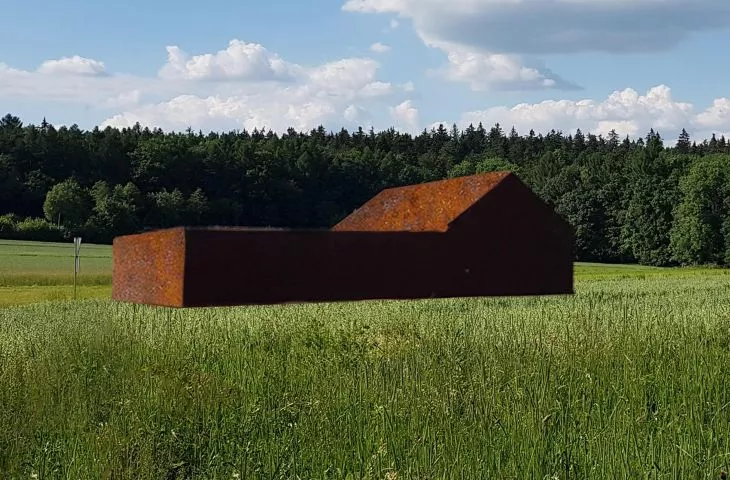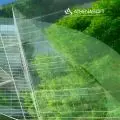A closed, rust-colored cuboid standing out against a green meadow is Fortress XS, a new project by architects from {tag:pracownie}. The minimalist single-family house, which resembles a contemporary fortress covered with corten, is being built in the vicinity of Ojcow National Park, and its form creates a strong contrast with its surroundings.
Fortress XS is a minimalist single-family home under construction near Krakow, which is an asylum. By placing windows on only one elevation and the possibility of completely obscuring it, residents can hide from the increased tourist traffic of the Ojcow National Park. While working on the project, architects Marcin Galas and Tomasz Smuga found inspiration in the form of ancient fortresses and the courtyard of the Wawel Royal Castle, among others.
Safe house as a contemporary fortress
© Autograf studio
The fortress as a defensive structure has been erected from antiquity until modern times. A completely new form of fortress is a house - a modern fortress. The place, which by design is supposed to create a safe zone for residents, gains additional attributes through the shape of the block and the movable facade [ ...]. Named XS because of its small size. Fitting into the neighborhood, the polygon is distinguished by its material - the solid, covered entirely in corten, resembles a spaceship, an enigmatic object that landed on a beautiful green meadow. Definitely cutting off from its surroundings, the geometric form looks as if pasted completely from another illustration, the architects explain.
The eastern elevation is completely glazed
© Autograf studio
Despite the clear cut of the brown-orange building, the house changes its expression with the seasons: it creates a strong accent in winter, cutting off against the white of the snow, in spring it contrasts with fresh greenery, to slowly disappear into the landscape in summer, completely melding with it in autumn. The minimalist architecture of the house is complemented by natural elements - greenery, rock and water. The inner courtyard of Fortress XS creates a private and cozy space, a garden integrated into the living room and kitchen, complementing the block. The mobile nature of the building's facade makes the massing changeable.
Fortress XS conceals an inner courtyard with a garden
© Autograf studio
Depending on the residents' preferences, the building can be open or completely closed to the surroundings. Exposing the glazed east elevation reveals the forest wall, the inner garden is accessible from the living room and kitchen also through glazing. When both sides are open, light enters the room from one side and the other creating the illusion of a levitating roof. On the other hand, completely closing the glazed facades creates a contemporary fortress. A home that is safe, sheltered from the sight of passersby, where you can relax peacefully in the inner garden.
Fortress XS is a modest block
© Autograf studio
Dobrawa Bies: Autograf Studio is known for its unconventional approach to design and bold buildings that defy the laws of physics. Forteca, on the other hand, is a modest building with a simple body. How did you come to this decision?
Autograf studio: Actually, our studio is best known for extravagant and provocative works, but it is always up to the investor to have the final say, and it is always the investor who decides how eccentric his house will be. For us, the choice of the form of the designed objects is always a resultant of the assumptions specified by the client, observations of the plot on which it is to be built, discussions on the ideas of what this architecture is and our author's interpretation of what we hear from the investor, or skillful pretending what we did not want to hear:) The lump of Fortress XS is by far of all our houses the most introverted, but from the first visit to the plot we knew that a total intervention was needed there. Ugly architecture adjacent to such a beautiful plot and the Ojcow National Park made a depressing impression, and it was certain that a categorical solution was needed there. A confident even aggressive form, which will decide to silence the cacophony of architectural forms around. A firm, strong sculpture of the building, but not extravagant - the opposite. Modest elementary geometry, box, box, four walls and nothing else. Intriguing minimalism and emanation of calm in the hustle and bustle of the environment. Mirroring the art world, it's almost like Marina Abramović's 2010 New York performance The Present Artist, in which the artist sat in silence and shared a moment of silence with random viewers. We wanted to achieve the effect of a noiseless presence, the enigmatic silence of the building block. Hence our decision to deprive all three walls of windows, eliminate all detailing and hide the front door, garage door, mask the courtyard and not distinguish any elevation. All that was to be left was a silent, unsocial cuboid in the middle of a green meadow.
The house is, in simple terms, a cuboid surrounded by a meadow
© Autograf studio
Dobrawa: What requirements did the investor set for you?
Autograf studio: This is a funny story. The investor set a requirement to adapt the design of a typical house to the conditions of the plot he had. It was only during the discussions held and the presentation of the concept that we managed to convince him that he had an exceptional site and it was simply a pity to sacrifice it for some triviality. The idea we presented of an introverted house, facing inward and remaining indifferent to the outside, did not immediately find understanding. We were not surprised by this, as it was a 180-degree turn; after all, only a moment earlier the client had been determined on a ready-made, catalog house. The final presentation and step-by-step analysis of all the design decisions we made managed to trigger the process of thinking architecture, as defined by Peter Zumthor in his book. We finally moved away from all the templated, mundane ideas and turned the train of thought in the direction of the think big. We presented the philosophy and ideological message of the project, convinced that regardless of the scale, also small intimate houses can also contain a great vision, and this eventually grabbed hold.
Dobrawa: Did the neighborhood of the Ojcow National Park also influence the shape of the house?
Autograf studio: The neighborhood of Ojcow National Park strongly influenced the entire design process. The main idea of the house arose from contradictory conditions, which incidentally, paradoxically, we enjoy every time they happen to us. Problems were posed, on the one hand, by quite a lot of tourist traffic towards the park, car traffic, the opening of the body of the building to the border of the tree line and the location of the building towards the north side. It was certain from the beginning of the search that the building with all rooms, including the bathroom and the master bedroom, would face the side of the Ojcow Park, but at the same time the problem of ensuring privacy and intimacy for the residents arose.
The architects created an isolated private garden space
© Autograf studio
At this stage, the need to isolate was immediately born! The thought of turning the house " inside out " and eliminating all the windows, and turning the house itself inside out. To create an inaccessible house, but only for outsiders, not for residents. A kind of fortress, a castle inaccessible from the outside, but with an inner courtyard. The context of the house near Krakow and the consideration of the courtyard immediately directed our thoughts to the Wawel Royal Castle. We wanted the courtyard in our house to have the same utilitarian but representative function. Thus, we created an isolated space, something like a private garden. The architectural story was completed by opening up the entire length of one elevation to the beautiful wall of the Ojcow National Park. From every corner of the house it is possible to get in touch with nature and observe the changing seasons. The living space is located exactly between the indoor garden and the outdoor garden, as we called the view of the park. Light enters the rooms from one side and the other, and homeowners live in the middle of two gardens. At any time it is possible to completely cover the glazed facade with panels. Then a block without any windows is created. A uniform, closed monolith. With a single gesture, we transform the Eden of paradise into a Fortress.
Rusty corten panels create a monolith
© Autograf studio
Dobrawa: Please tell us about the materials and construction solutions used.
Autograf studio: We wanted to decisively cut off the solid from its surroundings not only with a minimalist geometric form, but also with a plastic treatment. We were looking for a material that would additionally create dissonance, contrast, a thing uncomfortable to the eye. We wanted to achieve the effect of the distinctiveness of the building's sculpture against the background of the National Park. An intended expression of pride in its foreignness. To emphasize the abstraction of mathematical geometry. With all possible scenarios, we finally decided to use only one material through all the facades including the roof. The strongest counter to the green stain of the forest is red, so the choice of rusty corten panels made itself and, so to speak, beyond us.
Dobrawa: What posed the greatest design difficulty for you, and what are you most satisfied with?
Autograf studio: The biggest difficulty in the design process is never the design itself, but the conversations with the client. Trying to convince them of an idea, persuading them to move away from patterns and convincing them to think abstractly. Each time, it's a challenge to inspire a different narrative in imagining one's own home. The initial conversations and capturing the moment when the vision begins to dominate all other threads, when a hint of the anticipated madness finally begins to emerge.
What are we most satisfied with? Probably from the fact that the number of clients who are willing to trust us is steadily growing, and the fact that the kind of architecture we offer, unconventional, original and daring, is increasingly in demand. More and more often, clients who are not necessarily educated in the field of architecture, but certainly increasingly aware of what they want, are coming to Autograf Studio. This gives our projects a chance to be unique, because the investors know what to expect from us. A good illustration for this thesis will be the next projects about to come out of our studio: House Without Windows, or House Between Heaven and Earth. We are glad that during the presentation of concepts we are asking clients less and less often at the outset to keep an open mind and momentarily lose their sanity.
Dobrawa: Thank you for the interview!














































































